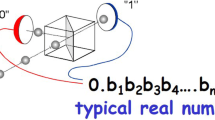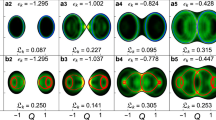Abstract
Actual realisations of EPR experiments donot demonstrate non-locality. A model is presented that should enable non-specialists as well as specialists to understand how easy it is to find realistic explanations for the observations. The model also suggests new areas where realistic (“hidden-variable”) models can give valid predictions whilst quantum mechanics fails. It offers straightforward explanations for some anomalies that Aspect was unable to account for, providing perhaps the first experimental evidence that a hidden-variable theory can besuperior to quantum mechanics. The apparent success of quantum mechanics in predicting results is shown to be largely due to the use of unjustifiable and biased analysis of the data. Data that has been discarded because it did not lead to a valid Bell's test may give further evidence that hidden variables exist.
Similar content being viewed by others
References
Aspect, A., “Trois tests expérimentaux des inégalités de Bell par mesure de corrélation de polarisation de photons,” Ph.D. thesis, Université de Paris-Sud, Centre D'Orsay (1983).
Aspect, A., Dalibard, J., and Roger, G., “Experimental test of Bell's inequalities using time-varying analyzers,”Phys. Rev. Lett. 49, 1804–1807 (1982).
Aspect, A., Grangier, P., and Roger, G., “Experimental realization of Einstein-Podolsky-Rosen-Bohmgedanken experiment: A new violation of Bell's inequalities,”Phys. Rev. Lett. 49, 91–94 (1982).
Baggott, J.,The Meaning of Quantum Theory (Oxford University Press, Oxford, 1992).
Bell, J. S.,Physics 1, 195 (1964).
Bohm, D.,Quantum Mechanics (Prentice-Hall, Englewood Cliffs, 1951).
Caser, S., “Objective local theories and the symmetry between analysers,”Phys. Lett. A 102, 152–8 (1984).
Caser, S. “Quantum mechanics as the limit of a symmetric local theory,”Phys. Lett. A 121, 331–333 (1987).
Clauser, J. F., and Horne, M. A.,Phys. Rev. D 10, 526–35 (1974).
Clauser, J. F., Horne, M. A., Shimony, A., and Holt, R. A.,Phys. Rev. Lett. 23, 880–884 (1969).
Clauser, J. F., and Shimony, A.,Rep. Prog. Phys. 41, 1881–1927 (1978).
Einstein, A., Podolsky, B., and Rosen, N., “Can quantum-mechanical description of physical reality be considered complete?”Phys. Rev. 47, 777–780 (1935).
França, H. M., Marshall, T. W., Santos, E., and Watson, E. J., “Possible interference effect in Stern-Gerlach phenomenon,”Phys. Rev. A 46, 2265–2270 (1992).
Gilbert, B. C., and Sulcs, S., “An exception to Bell's theorem,” submitted toEur. J. Phys., (1996).
Grangier, P., Potasek, M. J., and Yurke, B., “Probing the phase coherence of parametrically generated photon pairs: A new test of Bell's inequalities,”Phys. Rev. A 38, 3132–3135 (1988).
Grangier, P., Roger, G., and Aspect, A., “Experimental evidence for a photon anticorrelation effect on a beam splitter: a new light on single-photon interferences,”Eur. Lett. 1, 173–179 (1986).
Greenberger, D. M., “Two-particle versus three-particle EPR experiments,”Ann. N. Y. Acad. Sci. 755, 585–599 (1995).
Jack, C., “Sherlock Holmes investigates the EPR paradox,”Physics World, April (1995).
Kleinknecht, K.,Detectors for Particle Radiation (Cambridge University Press, Cambridge, 1986).
Lepore, V. L., and Selleri, F., “Do performed optical tests disprove local realism?”Found. Phys. Lett. 3, 203–220 (1990).
Marshall, T. W., and Santos, E., “Comment on ‘Experimental evidence for a photon anticorrelation effect on a beam splitter: a new light on single-photon interferences'”:Eur. Lett. 3, 293–6 (1987).
Marshall, T. W., Santos, E., and Selleri, F., “Local realism has not been refuted by atomic-cascade experiments,”Phys. Lett. A 98, 5–9 (1983).
Pascazio, S., “Variable detection probability models for Einstein-Podolsky-Rosen-type experiments,”Quantum Mechanics versus Local Realism: The Einstein-Podolsky-Rosen Paradox, F. Selleri, ed. (Plenum, New York, 1988), p391.
Pearle, P., “Hidden-variable example based upon data rejection,”Phys. Rev. D 2, 1418–25 (1970).
Rae, A.,Quantum Mechanics (McGraw-Hill, New York, 1981).
Rarity, J. G., and Tapster, P. R., “Experimental violation of Bell's inequality based on phase and momentum,”Phys. Rev. Lett. 64, 2495–2498 (1990).
Risco-Delgado, R., “The variable detection approach: a wave particle model,”Found. Phys. Lett. 6, 399–428 (1993).
Selleri, F.,Quantum Mechanics Versus Local Realism: The Einstein-Podolsky-Rosen Paradox (Plenum, New York, 1988).
Shurcliff, W. A., and Ballard, S. S.,Polarized Light (Van Nostrand, New York, 1964).
Author information
Authors and Affiliations
Rights and permissions
About this article
Cite this article
Thompson, C.H. The chaotic ball: An intuitive analogy for EPR experiments. Found Phys Lett 9, 357–382 (1996). https://doi.org/10.1007/BF02186307
Received:
Revised:
Issue Date:
DOI: https://doi.org/10.1007/BF02186307




